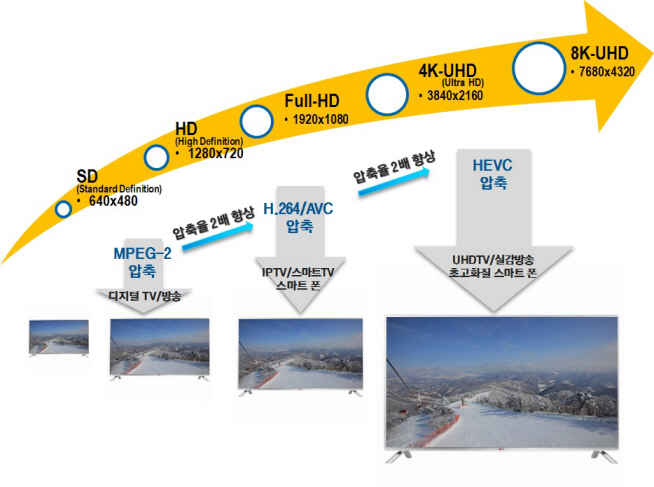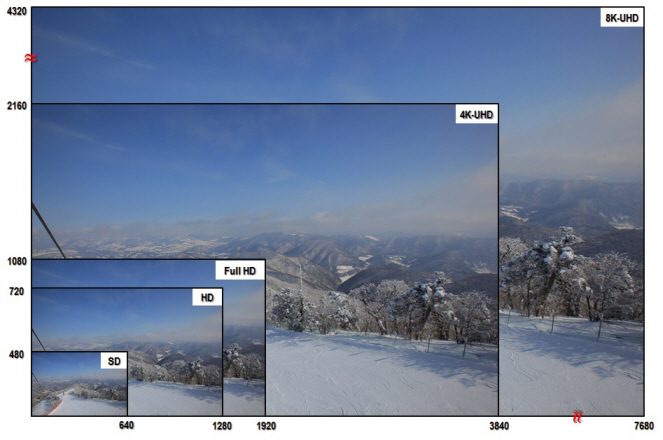people
A video compression technology, jointly developed by Professor Mun-Chul Kim of the Department of Electrical Engineering at KAIST, the Electronics and Telecommunications Research Institute (ETRI), and the Korean Broadcasting System (KBS), is registered internationally as the standard patent in the next-generation High Efficiency Video Coding (HEVC).
HEVC (H.265) is an international technology standard that compresses large image data for Ultra High Definition (UHD) televisions and smartphones. It has the twice the compression efficiency as that of H.264/AVC which is most commonly used for processing full HD sources. This means that it is able to compress a video file to half the size while maintaining the same image quality.
Although the related market is at a nascent stage, HEVC technology has already been applied to the latest version of televisions and smartphones. Experts predict that the market will grow to USD 200 billion by 2016, and KAIST is expected to receive a royalty payment of USD 9.3 million from this patent.
The International Organization for Standardization (ISO/IEC) established the HEVC standard in January 2013. Also, an international patent pool licensing corporation, MPEG LA announced the HEVC standard patent pool on September 29, 2014.
Professor Joongmyeon Bae, Dean of the Office of University-Industry Cooperation (OUIC) of KAIST, said, “This is an unprecedented case for Korea whereby a core technology developed by a university became an international standard, which has a vast impact on the market.”
President of KAIST, Steve Kang commented, “With its advanced technology, KAIST joined the HEVC standard patent pool as one of the 23 founding members along with Apple, Siemens, and NEC. This is a remarkable achievement.”
Picture 1: Improvements in video compression technology

Picture 2: Comparison of different screen resolutions

-
research Synthesizing Single-Crystalline Hexagonal Graphene Quantum Dots
(Figure: Uniformly ordered single-crystalline graphene quantum dots of various sizes synthesized through solution chemistry.) A KAIST team has designed a novel strategy for synthesizing single-crystalline graphene quantum dots, which emit stable blue light. The research team confirmed that a display made of their synthesized graphene quantum dots successfully emitted blue light with stable electric pressure, reportedly resolving the long-standing challenges of blue light emission in manufa
2019-08-02 -
people KAIST Co-owns the HEVC Patent Portfolio License
MPEG LA, LLC, a firm based in Denver, Colorado, which licenses patent pools covering essential patents required for the use of video coding technology, such as MPEG-2, MPEG-4 Visual (Part 2), and HEVC/H.264, announced the availability of the High Efficiency Video Coding (HEVC) Patent Portfolio License on September 29, 2014. The HEVC standard, also known as H.265 and MPEG-H Part 2, is necessary to improve video coding and transmission efficiency for the Internet, televisions, and mobile gadgets
2014-10-02 -
event The 9th International Conference on Entertainment Computing Held, Sep 8-11, 2010
The cyber world is no longer an unrealistic place for a contemporary man who spends most of his time in front of a computer nowadays. The entertainment contents industry, which materializes the cyber world, leads the new knowledge economy and is emerging as a new growth engine for high value-added industry. Professionals in entertainment computing gathered to discuss how to make the cyber space more elaborate and entertaining. The 9th 2010 International Conference on Entertainment Computing
2010-09-17 -
event 133 Diplomats Worldwide Visit KAIST
THE KAIST Herald April 8, 2004by jong-kyoung Kim On March 12, diplomatic corps in Korea visited Daedeok Valley"s KAIST after taking a trial run on the Korea Train eXpress(KTX). Composed of ambassadors from 79 nations and 54 international organizations, the 133 diplomatic corps went on board KTX at 10:30 AM in Seoul and arrived in Daejeon at 11:20 AM. Shortly after arrival, the diplomatic corps attended a luncheon hosted by the Minister of Foreign Affairs and Trade(MOFAT) before paying visits
2004-04-20